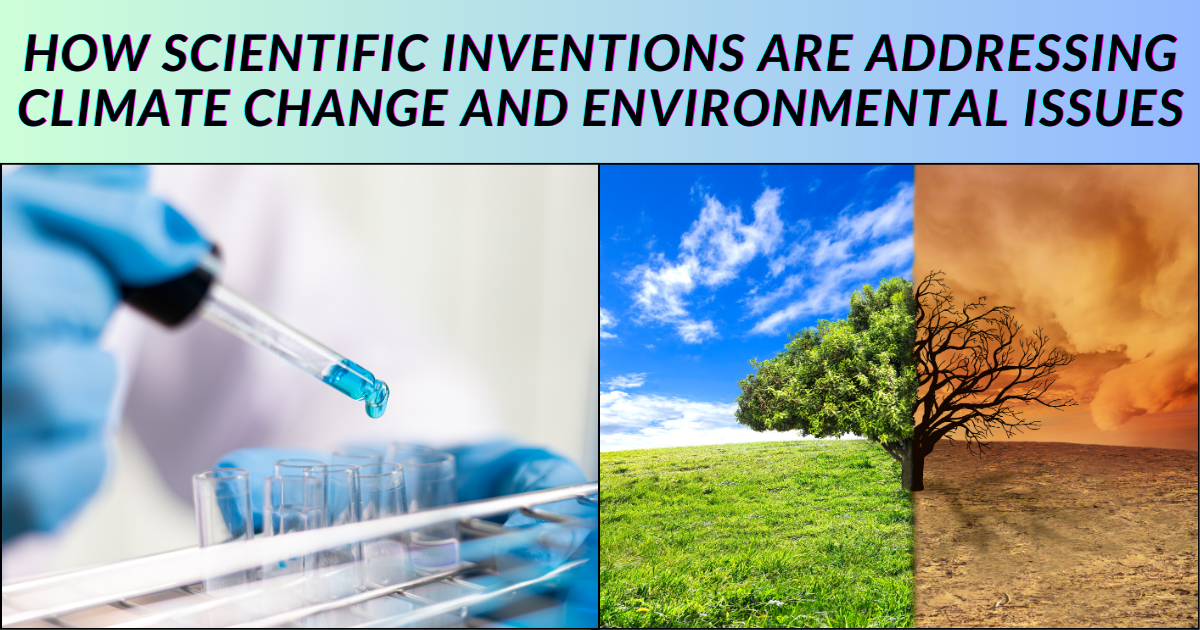How Scientific Inventions Are Addressing Climate Change and Environmental Issues. In today’s era, one of the major problems on our planet is climate change and environmental issues. These are rapidly rising and harming the Earth. Scientists are trying their best to invent tools and machines to reduce these significant problems, including global warming and ocean defertilization. To know more about the topic “How Scientific Inventions Are Addressing Climate Change and Environmental Issues,” please read the complete article.
How Scientific Inventions Are Addressing Climate Change and Environmental Issues
There are many scientific inventions that are made to address climate change and environmental issues, and many inventions are in the process. Climate change is a major issue for every living creature on this planet, including human beings, animals, and plants. With the help of AI, scientists have developed more inventions and research to reduce environmental challenges. Science works more complexly than we imagine. It starts from a hypothesis and by making observations to drawing conclusions by analyzing and interpreting data, and finally publishing results.

Human activity has caused the global climate to change dramatically, resulting in droughts, hurricanes, and floods. In addition, this change has harmed the earth’s environment, wildlife, and natural ecosystems. Therefore, scientists have invented new methods to minimize these issues-for example, 3D printing machines use minimal energy to stay at a steady temperature. Scientists have also created hybrid cars that run on both fossil fuels and electricity, which assists in lowering emissions.
Scientific Inventions To Fight Climate Change and Environmental Issues
There are many scientific inventions already made and many in progress to fight climate change and environmental issues. Let’s discuss some of them briefly:
Perovskite Solar Cells
Perovskite solar cells have captured attention due to their high efficiency and low production costs. Perovskites commonly used in photovoltaic (PV) solar cells are more specifically called “metal-halide perovskites” since they are made of a combination of organic ions, metals, and halogens; perovskites in other applications may be made of oxygen instead of halogens and are usually entirely inorganic.
Offshore Wind Farms
Many coastal areas have very high energy requirements. Half of the United States’ population lives in coastal areas, with significant populations in major coastal cities. Building offshore wind farms in these areas can help to meet those energy requirements from nearby sources. These farms can be expensive and difficult to build and maintain. Since consumer demand is at its highest in the afternoon and evening, offshore wind speeds are at their highest in many locations where this project is being planned.
Concentrated Solar Power (CSP)
Concentrated solar power (CSP) is an alternative to generating power via mirrors. The mirrors reflect, concentrate and focus natural sunlight onto a specific point, which is then converted into heat. The heat is then used to produce steam, which drives a turbine to generate electrical power. These power systems are usually deployed for utility-scale projects. It can also be used in a number of industrial applications, like water desalination, increased oil recovery, food processing, chemical production, and mineral processing.
Carbon Capture and Storage (CCS)
Carbon Capture and Storage (CCS) is a significant technology to assist in the decarbonization of the global economy. Three steps are involved: first, the CO₂ generated by power generation or industrial processes, like the production of hydrogen, steel, or cement, must be captured; second, it must be transported; and third, it must be permanently stored underground. CSS involves the capture of CO₂ emissions from industrial processes, such as steel and cement manufacturing, or from the burning of fossil fuels in the generation of electricity.
Electric Vehicles
All forms of electric vehicles (EVs) can assist in enhancing fuel economy, reducing fuel costs, and minimizing emissions. Using electricity as a power source for transportation boosts public health and the environment. It also provides safety benefits and leads to a resilient transportation system. Compared with regular cars, EVs offer lower running costs. EVs operate significantly more quietly and smoothly than conventional cars because electric motors generate less vibration and noise.
Digital Platforms for Sustainability
Digital sustainability, which includes the use of technologies in regular business applications. It is used to solve climate-related issues and improve Environmental, Social and Governance (ESG) outcomes. It can play a significant role in fighting climate change. These platforms provide marketplaces where transactions can be made in more cost-efficient and climate-friendly ways, promote sustainable product innovation or inform consumers about their climate footprints.
